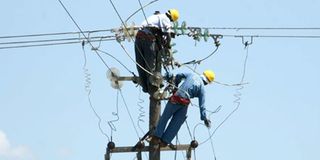ERC: New licensing regime in Kenya

The new rules are expected to usher the electricity sector into a more vibrant platform. Photo/FILE
Applicants for electricity generation, transmission and distribution will be required to state the clients upfront in new rules. This will form part of the detailed application process that interested investors will have to meet in the licensing regime.
The Energy Regulatory Commission published the regulations in the Kenya Gazette last Friday. The new rules are expected to usher the electricity energy sector into a more vibrant platform in order to satisfy the growing demand in Kenya. The rules cited as the Energy (Electricity Licensing) Regulations, 2010 will apply to persons intending to carry out generation, transmission, distribution and supply of electricity in Kenya. According to the new regulations for example, applicants for the transmission licence will be required to provide information supporting their business plans.
The prospective licensee will have to provide particulars of persons from whom and at which points they expect to receive their supply for a period of five years. The details will also include proposed metering arrangements, forecast annual maximum demands for each of the next five years in this transmission system. On the other hand, applicants for production of electricity will be required to provide to the commission the number of generation plants or stations to be operated. Additionally, they will be required to supply details on how each of the generation plants will be powered and the proposed dates for commissioning of the stations.
Life of each plant
Over and above, applicants will also have to provide information on the expected life of each plant, the number of generating units for up to five years and the efficiency of each mode of generation it chooses. Details of the of entities to whom the applicant intends to provide the electricity to for five years will also be crucial in getting the licensing.
The ERC proposes to charge Sh10,000 per MW installed for licensing of electricity generation. A further Sh5,000 per MW installed for renewal, modification or transfer of the licenses. For transmission, the commission will charge Sh2,000 per MW of transfer capacity with an annual renewal fee of Sh1,000 of transfer capacity.
Distributors of electricity will, however, pay Sh1, 00 per GWhr, a price for energy proposed for supply in the first year of operation and for renewal based on actual capacity supplied. The public is expected to submit comments on the regulation to the commission over the next 40 days.
Single buyer
Kenyan electricity supply structure is currently based on the single buyer model. This has seen over the years electricity producers sell power in bulk to Kenya Power and Lighting Company. The firm is in turn mandated with tasks of dispatch, transmission, distribution and supply functions throughout the country.
However, over the past few years KPLC has encountered technical challenges plunging the country into complete darkness. The latest of such mishaps occurred on the eve of the New Year 2010. The growing demand for electric power has in the past year sent government operatives into creating avenues of opening up the sector.
This has seen a new approach by the State to diversify its generation, transmission and distribution of electricity energy. Already the government has formed the Kenya Electricity Transmission Company (KETRACO) for transmission ostensibly to lessen the burden of KPLC. Another outfit Geothermal Development Company (GDC) has also been set up to undertake geothermal resource assessment and steam production for power generation purposes. Kenya intends to raise Sh383 billion over the next five years to boost generation, transmission and distribution of electricity.
This comes against the backdrop of rising demand from consumers projected to peak at 2029 megawatts (MW) by 2014. The demand has been pinned on increased economic growth in the country, currently put at 1,334MW. The governments’ proposal indicates an extension of transmission lines on the national grid by 2,500 kilometres and improvement on the quality of power distribution.
Electricity distribution is also to be enhanced through extending current lines by 3,440 kilometres and establishing 63 primary distribution stations. These plans are supposed to be complemented by geothermal resources. The government envisions that it would drill 120 wells to provide steam that can provide an equivalent of 500MW. These will cost Sh58.7 billion to be implemented by the Geothermal Development Company (GDC).




